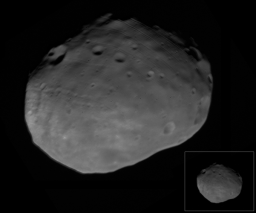Emily Lakdawalla • Jul 22, 2008
Stay tuned for new views of Phobos from Mars Express
Mars Express has been at Mars since January 2004, and its mission has already been extended a couple of times. Under an agreement with NASA, Mars Express was required to maintain a specific orbital configuration during the descent of Phoenix to Mars so that all three of the Mars orbiters could listen for Phoenix' radio signal. Now that Phoenix is safely on the ground, Mars Express' mission controllers are free to shift the spacecraft's orbit so that it can view new targets, namely, Phobos, the inner of Mars' two moons.Mars Express has already taken lots of images of Phobos, but the vagaries of orbital mechanics have prevented it from getting a good look at the trailing hemisphere of the moon (the side of the moon that faces backward along its orbit around Mars). Since the trailing hemisphere is where the Russian sample return mission Phobos-Grunt is supposed to touch down, it's imperative that we get better maps of that region than are available from Viking, which did image all of Phobos but perhaps not at the resolution that the Russian space agency would like to see.

ESA / DLR / FU Berlin (G. Neukum)
Sub-Mars to trailing side of Phobos
Mars Express captured these views of Phobos on January 20, 2006. The larger view was taken by the Super Resolution framing camera of the Mars Express HRSC instrument, which produces significantly blurred images. The smaller view was taken by the HRSC pushbroom camera at the same time. Mars Express will shortly be getting better views of the trailing side of Phobos (toward the right side of the globe in this image) thanks to a shift in its orbit.| Date | Altitude |
|---|---|
| July 12 | 563 km |
| July 17 | 273 km |
| July 23 | 97 km |
| July 28 | 361 km |
| August 3 | 664 km |
If this were a NASA mission I could be confident that we'd see images online within days or even hours of the flyby. But this is ESA and they don't do things the same way -- they don't release raw versions of their images, and they often wait for scientific publications (which can take many months) to release just a few pictures. But I just asked project scientist Agustin Chicarro about the plans for image releases, and I am delighted to report that they have every intention of releasing images the day after the encounter! So stay tuned for that. In the meantime, enjoy this montage I put together a while back, showing what Mars Express has managed at Phobos to date.
 HRSC images of Phobos as of April 2008 A montage of 44 images of Phobos (nearly the entire catalog) taken by Mars Express and released to ESA's Planetary Data System as of April 2008. They have been roughly sorted and oriented according to their viewing geometry. Views of the equatorial regions of the leading hemisphere are in the center; the sub-Mars hemisphere is to the right; the anti-Mars hemisphere is to the left; north polar views are toward the top; and south polar views are toward the bottom. Mars Express had not (as of April 2008) acquired any views centered on the trailing hemisphere. Credit: ESA / DLR / FU Berlin (G. Neukum) |
Support our core enterprises
Your support powers our mission to explore worlds, find life, and defend Earth. You make all the difference when you make a gift. Give today!
Donate

 Explore Worlds
Explore Worlds Find Life
Find Life Defend Earth
Defend Earth

